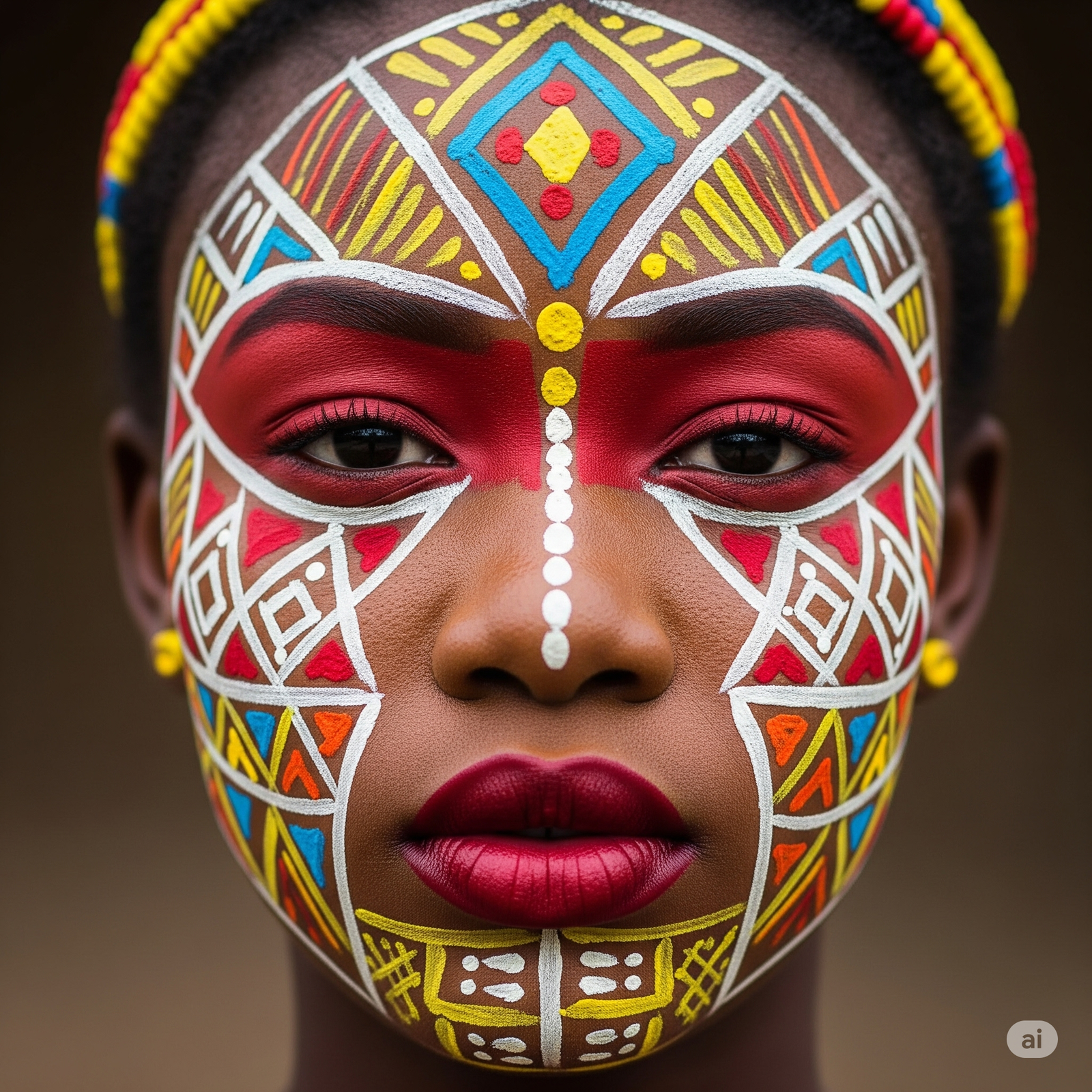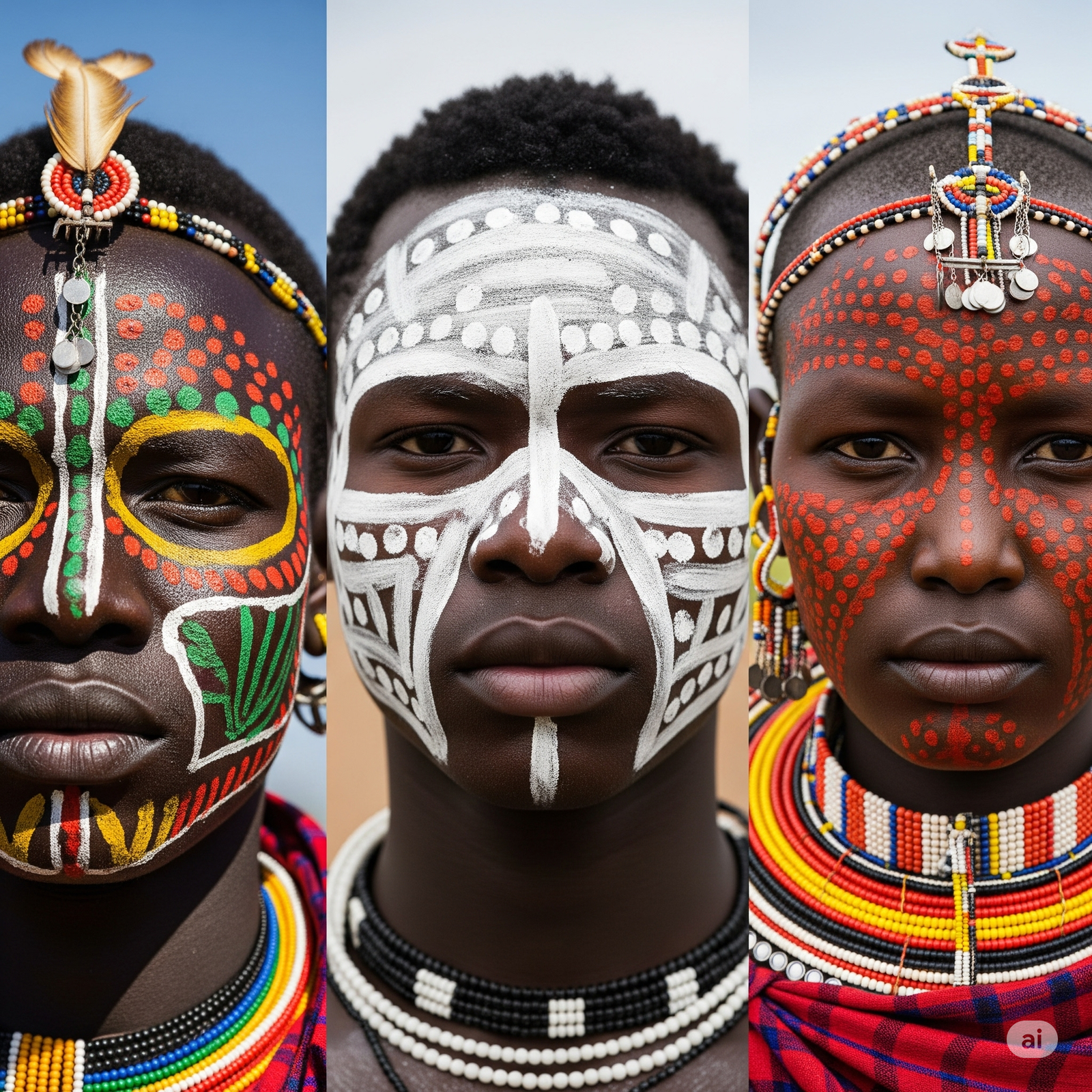African Tribal Paint: Cultural Identity in Every Line
Explore the symbolism of African tribal makeup and heritage face paint beauty. Admigos animates identity through ancestral motion rooted in color, rhythm, and respect.
14 Jul'25
By Niharika Paswan


African Tribal Paint: Cultural Identity in Every Line
Long before foundation palettes and highlighter pans, there was the earth. Clay, ash, chalk, charcoal. The original pigments. Before beauty became product, it was purpose, paint worn for initiation, ceremony, protection, mourning, victory, and identity. Across the continent, African tribal makeup has always been more than cosmetic. It’s ancestral memory made visible.
Each line painted, each color chosen, each pattern placed, none of it random. Every element carries meaning. In many African cultures, face paint is not about decoration, it’s about declaration. Who you are. Where you come from. What your body is holding in that moment. Joy, grief, power, transformation.
Today, in a world where beauty visuals are consumed in seconds, these ancient forms of expression are finding new life through animation. Not as trends, but as stories. Not for appropriation, but for preservation. And with care, respect, and collaboration, brands and creators can help keep these traditions alive in motion.
Let’s explore what makes tribal face paint so rich in meaning, and how beauty storytelling can honor that heritage without flattening it.
Symbolism in Every Color

In African tribal paint traditions, color is never aesthetic for the sake of it. It speaks. It signals.
- White, often made from ash or kaolin clay, may symbolize purity, death, or the spirit world, depending on tribe and context.
- Red, sourced from ochre or animal blood, is tied to strength, vitality, even fertility. Among the Himba of Namibia, red ochre is worn daily as identity and armor.
- Black, made from charcoal or soot, can mean power, mourning, protection, or transition. It’s both grounding and intimidating.
- Yellow and orange often mark celebration or harvest sun tones associated with joy, energy, life.
These meanings shift between regions, languages, and tribes but what remains constant is the intentionality. There is no such thing as “just for the look.” Each face becomes a map. A visual language passed from elder to child, healer to initiate, warrior to witness.
The Face as Protest and Art

In many African cultures, the painted face is political. It’s resistance in pigment. It tells the world: “This is who I am, and I am not erasing it.”
Colonial powers attempted to ban face paint. Missionaries deemed it savage. Western governments saw it as threat. And yet, it endured. In secret. In ceremony. In quiet defiance.
Today, tribal patterns appear on the runways of Paris, in Beyoncé videos, on Instagram grids but the difference is intention. Are you referencing, or are you reviving? Are you appreciating, or are you profiting?
For those rooted in these traditions, face paint remains sacred. A Dinka man in South Sudan paints to mark age and status. A Xhosa youth wears white for ulwaluko, the rite of passage into manhood. A Maasai woman might line her face in red to signal strength in marriage or widowhood.
These aren’t trends. They’re stories worn on the skin.
Animation as a Preservation Tool
Photography has always struggled to do tribal paint justice. You lose the shimmer of clay, the crackle of drying pigment, the ritual of application. What static visuals freeze, animation can revive.
Through careful, respectful animation, we can:
- Recreate pigment being ground and mixed
- Show face paint being layered in slow sequence
- Animate the movement of dancers in ceremonial wear
- Let traditional drum rhythms sync with visual beats
- Blend archival footage with modern digital art
- Zoom in on skin textures how the earth pigment blends, dries, flakes
This doesn’t flatten heritage into trend. Done right, it honors. It becomes an archive that lives and breathes, not just sits still.
And when these visuals are guided by artists from the cultures they represent, the work becomes more than storytelling, it becomes survival.
Admigos Honors Beauty Rooted in Ancestry
At Admigos, we understand that not all beauty comes from brands. Some of the most powerful looks we animate come from lineage, not labs. From rituals passed down by word, not written.
When it comes to African tribal makeup, we collaborate with artists, anthropologists, and community historians to ensure every visual is built with accuracy and respect. Our goal isn’t to modernize ancestral beauty. It’s to help it move with dignity. With memory. With emotion.
We animate face paint not as spectacle, but as storytelling in pigment. We zoom in on the hands that paint, not just the face. We animate the hush before ceremony, the drumbeat during, the stillness after.
Because this isn’t content. It’s culture.
The New Wave: Creators Carrying Legacy
There’s a rising generation of African creators using animation, reels, and digital art to preserve what was nearly lost:
- Beauty filmmakers in Nigeria using traditional pigment tones in modern makeup tutorials
- South African illustrators animating face paint designs based on childhood memories
- Fashion stylists blending ancestral patterns into present-day shoots and using motion to explain them
- Creators using face paint not just for beauty, but for education and pride
What makes this powerful isn’t just the look, it’s the context. Every line drawn on their faces carries a story. And animation helps that story reach further, last longer, resonate deeper.
This isn’t nostalgia. This is revival.
Final Thought: Not Just Paint. Not Just Pretty.
In Western beauty, makeup is often about enhancement: prettier, sharper, newer. But tribal face paint isn’t trying to improve anything. It’s revealing. Identity. Connection. Truth.
When animated with care, this tradition becomes a moving monument to the people who wore it first and the ones who still carry it now.
So let the clay crack. Let the red line smudge. Let the charcoal streak with sweat.
Let the face tell the story.
— By Niharika Paswan
Mughal Kohl: The Eyeliner Legacy
Explore the legacy of Mughal makeup and kohl eyeliner heritage. Admigos revives ancient beauty rituals through animation rooted in elegance and cultural memory.

The Vanity Edit: Clean Girl Shelf Meets Motion
Transform your skincare display into a visual story—where chic shelves become cinematic routines from sunrise glow to midnight calm.
